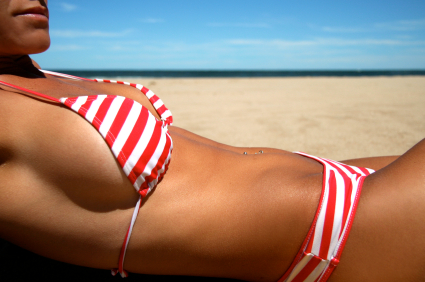Bikinis, Babes, and Buying

Scantily clad women have been used to sell products to men for decades, and likely for millennia in one form or another. There’s little doubt that the typical male brain is wired to respond to attractive females in revealing attire. But is this a cheap attention-getting trick that has no real impact on sales, or does it actually work? Researchers shed new light on this topic by exposing subjects to either videos of women in bikinis or more neutral videos, and evaluating their decision making ability.
The results of the tests, reported in a paper in the Journal of Consumer Research titled “Bikinis Instigate Generalized Impatience in Intertemporal Choice,” suggests that guys studying bikini-clad girls make worse decisions.
In each test, the researchers offered the men the choice between being paid 15 euros immediately or bargaining for a larger sum that they’d be willing to wait a week or a month for. In all the tests, the men exposed to the sexy imagery or bras cited delayed reward amounts that were lower than the amounts cited by the men who saw sex-neutral imagery. For example, while a man who looked at landscapes might have demanded an extra payment of 10 euros a month later (totaling 25), the bikini-gazer might have been willing to settle for five extra (totaling 20). The sexy imagery did not work on all men all the time, but, as a group, men with sex on their brains settled for a less lucrative bargain, suggesting they were more impulsive and valued immediate gratification more than the controls. [From MSNBC.com – Science proves that bikinis turn men into boobs by Brian Alexander.]
An earlier study, “Heat of the Moment: The Effect of Sexual Arousal on Sexual Decision Making,” by neuroeconomics expert George Loewenstein of Carnegie Mellon University and Dan Ariely of MIT, similarly showed that young men who were sexually aroused made quite different decisions about things like having unprotected sex or getting their partner drunk to make her more pliable. As in the bikini study, being sexually aroused caused the male subjects to be more focused on short-term gratification than on long-term logic.
In general, though, all our brains, Loewenstein believes, can be thought of as being of “two minds,” there is the affective system,( “Dude! Who cares what it costs! She’s hot!”) which answers to our basic drives, and the deliberative system (“That’s your IRA contribution!”). To think of this another way, picture an angel on one shoulder and the devil on the other. Even in the heat of the moment, there is still that little voice that says “You know you are making a mistake” – the trouble is it gets drowned out by the volume of the affective system.
We are constantly negotiating between these two systems, which is why economists are so interested; it’s how we make purchasing decisions.
What does this mean for marketers? Do bikinis really sell? To begin with, this effect seems to be a short-term one that would be most effective at the point of purchase. The ideal selling situation, no doubt, would be to have the bikini-clad babe selling to the guys in person. That would ensure both maximum impact and the ability to direct the purchasing behavior to the desired product. Most products aren’t conducive to such a sales approach, though, and a somewhat effective alternative might be posters, point-of-purchase displays, ane even product packaging. Marketers, of course, should be aware that female buyers might find the same images off-putting and use them judiciously. In addition, marketers should ensure that the images are consistent with the brand image – it would make no sense to cheapen a brand’s perception for a fleeting sex appeal boost.
Something that marketers need to watch out for, though, is the reverse neuromarketing effect of sexy advertising – as we reported in Sex Doesn’t Sell?, sexual images and situations can actually reduce brand recall. (That research compared recall of ads running on sexy television shows with those on tamer fare.)
In short, for products where bikini-clad babes represent an appropriate marketing strategy (I’ll let you be the judge of what those product categories are!), the place to put them is at the point of sale. I’d use them in ads more distant from the point of purchase, like television commercials or print ads, only if they are an integral and long-running element of the brand strategy (e.g., Hooters restaurants).
